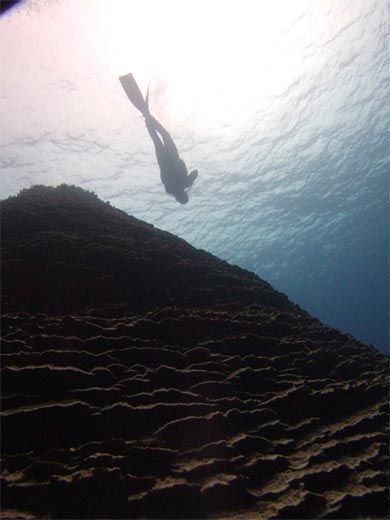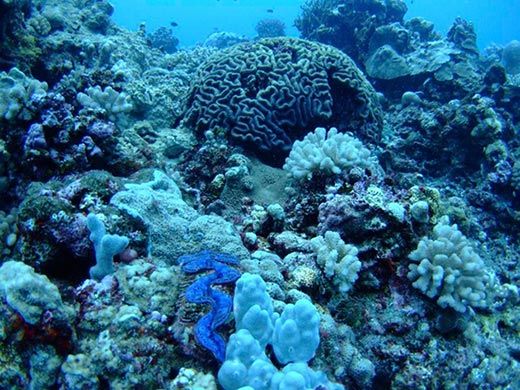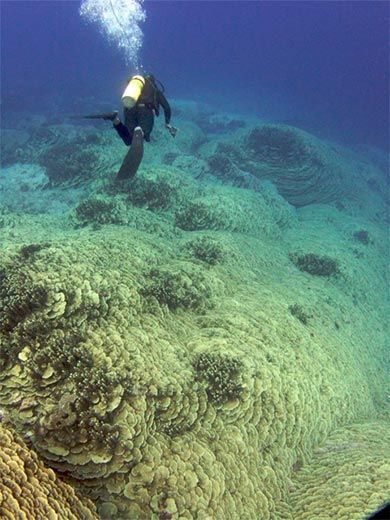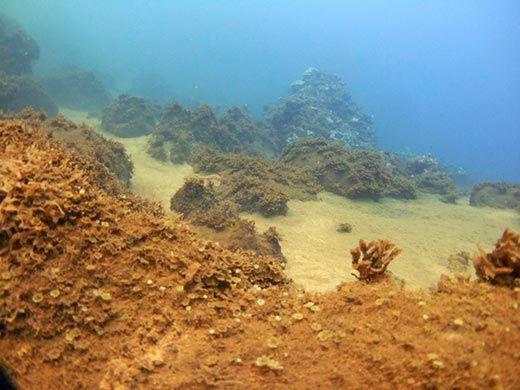A Swim Through the Ocean’s Future
Can a remote, geologically weird island in the South Pacific forecast the fate of coral reefs?
/https://tf-cmsv2-smithsonianmag-media.s3.amazonaws.com/filer/coral-and-benthic-communities-Maug-Island-631.jpg)
I drop the dinghy’s anchor below the red-streaked cliffs of Maug. The uninhabited island group is among the most remote of the Mariana Islands, which are territories of the United States in the Western Pacific. Maug's three steep, parentheses-shaped islands are the top of an underwater volcano.
Maug, part of the Marianas Trench Marine National Monument, is one of a string of underwater volcanoes—some active and spewing mud, sulfur and carbon dioxide—that boasts some of the world’s most spectacular geology. A nearby seamount hosts the only known sulfur lake this side of Jupiter. And Maug is the only place in the world where underwater volcanic vents emit carbon dioxide in a tropical, shallow-water environment.
Wearing a mask and fins, I slide into the water and swim north for a short trip into the future of our oceans.
As I start paddling against the current along the inner shore of the eastern island, I see abundant small fishes and plenty of coral heads washed in pastel blue, pink and white. Then the water gets warmer and murkier and there is less and less coral. Another 100 feet and I start seeing little bubbles rising in bursts from among the small rocks on the bottom, which are covered in brown slime called cyanobacteria. The small fishes disappear, a sign the water quality is changing.
Where the bubbles come out, the pH of the water is 6.07, a level of acidity that would kill all life in the oceans. A few feet away, where I swim, the acidic emissions have been diluted to a pH of 7.8, which is what scientists predict surface ocean water will average in half a century.
This is the death zone—dark and foreboding, and not a pretty sight. But it’s utterly fascinating to Rusty Brainard, head of the National Oceanic and Atmospheric Administration’s Coral Reef Ecosystems Division, who was among the first to swim through it in 2003. That's because, he says, it may help us understand how reefs around the world will react to an acidifying ocean.
Since the Industrial Revolution, humans have emitted a mind-boggling 500 billion metric tons of carbon dioxide (CO2) into the atmosphere. This heat-trapping gas caused the planet—which was poised for 100,000 years of cooling driven by variations in the Earth’s orbit—to get warmer instead.
Ken Caldeira, a climate change scientist at the Carnegie Institution’s Department of Global Ecology at Stanford University, says we’re spewing out 30 billion tons of CO2 a year from burning coal and oil, plus another 7 billion tons from the indirect effects of deforestation and making cement. In comparison, he says, the natural CO2 production from volcanic vents, in the air and in the water, is about half a billion tons a year.
About a third of the CO2 that has been emitted since the year 1800 has been absorbed by the oceans, which means our climate isn’t as hot as it would be otherwise. But what’s good for polar bears is not good for corals: CO2 in the water turns into carbonic acid, which has increased the acidity in the top 300-foot layer of the ocean by 30 percent.
As ocean water becomes more acidic, corals and shellfish must spend more energy to make their calcium carbonate shells, a process known as calcification.
“Already, the rate at which corals grow in the Great Barrier Reef has fallen by 15 percent in less than 20 years,” says Ove Hoegh-Guldberg, director of the Center for Marine Studies at the University of Queensland, Australia. “At this rate, corals will start to decline probably in 25 years.” Calcification will plummet to minimal levels–in which coral growth is barely perceptible–by the middle of the century, Hoegh-Guldberg calculated in a paper published in Science in December 2007.
Many reefs are already stressed by temperature spikes that kill coral colonies in a process called bleaching and by the overharvesting of fish that keep coral-smothering algae in check. “It doesn't take much of a decrease in reef calcification for coral reefs to begin to crumble and erode away,” Hoegh-Guldberg explains. “That leaves all the fish and the species that support them in the coral reefs essentially homeless, so they’ll just disappear.”
Hoegh-Guldberg published evidence for this scenario in 1999. Today he is no longer a lonely Cassandra. Many researchers believe that by mid-century, when atmospheric CO2 will be double what it was in 1800, “all coral reefs will cease to grow and start to dissolve,” asserts Jacob Silverman of Hebrew University of Jerusalem in a paper published in March in Geophysical Research Letters.
“Predicting the effect of acidification on coral is relatively easy,” says Caldeira of Carnegie, who coined the term “ocean acidification.” “We know it will make it harder for a lot of other marine species to reproduce, we just don’t know to what extent.”
The problem is that while there have been several periods during which the ocean has been much more acidic than it’s expected to be in a century, the process took at least 5,000 years, which gave marine species much more time to adapt. Now the process is 1,000 times faster than ever before, says Hoegh-Gulberg, which is why he worries about mass extinctions.
Which brings us back to Maug.
The unique death zone, where the water is so acidic from the volcanic vents that no coral can survive, is only 30 feet across and 200 feet long. After I swim out of it into gin-clear water full of fish and coral, I turn around and head back south, with the current, past the vents. Both the death zone and the transition zone, where highly acidic water merges with normal sea water, should yield insights into how corals will react to a changing ocean.
“This is the only shallow reef we know of where certain spots look just like we expect a lot of reefs will look like in 50 or 100 years,” Brainard says in his office in Honolulu. “We need to study what goes on in the space between the dead zone and normal one to find out exactly how corals react to increasingly acidic water.”
Because the ocean absorbs CO2 so slowly and there is already so much in the atmosphere, acidification will be much harder to reverse than climate change. As I swim back to the boat, I wonder how much coral my (hypothetical) grandchildren will see. They will certainly see ample and captivating photographs and film footage of coral reefs. Unlike the unphotographed dodo, our reefs, even if they are reduced to sand, will live on in our imagination.




